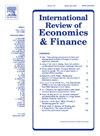Quantile time-frequency spillovers among climate policy uncertainty, energy markets, and stock markets
IF 4.8
2区 经济学
Q1 BUSINESS, FINANCE
引用次数: 0
Abstract
From a spillover network perspective, this study employs the QVAR-DY and QVAR-BK models to detect how global climate policy uncertainty (CPU) interacts with energy markets, encompassing coal, crude oil, natural gas, and clean energy, as well as stock markets in both the US and China within a quantile time-frequency framework. Results reveal that spillovers among CPU, energy and stock markets show heterogeneity under quantile time-frequency domains. The total connectedness is dominated by short-term shocks and becomes more significant within extreme market conditions, particularly during the COVID-19 pandemic. Moreover, in the normal market, clean energy and the US stock market act as net shock exporters, while the roles of the other variables within the system vary significantly across different frequencies. It is noteworthy that CPU changes from a short run net shock receiver to a medium and long run net shock transmitter. The spillover from Chinese stock market to CPU is more significant than that from other markets, especially during the short run. In extreme markets, the coal market exports spillovers, whereas the clean energy market imports them. These findings are crucial for controlling the spread of cross-market risk in the context of climate policy uncertainty. Relevant regulatory authorities should establish a short-term risk early warning mechanisms for climate policy, energy and stock markets under extreme markets, especially strengthening cross-market risk monitoring when major events occur. As CPU evolves into a spillover exporter over the medium to long run, strengthening the co-design of climate policy and clean energy market and guiding capital flows to low-carbon sectors will be critical for mitigating cross-market risk contagion and ensuring systemic stability.
气候政策不确定性、能源市场和股票市场之间的分位数时频溢出效应
从溢出网络的角度来看,本研究采用QVAR-DY和QVAR-BK模型,在分位数时频框架内检测全球气候政策不确定性(CPU)如何与能源市场(包括煤炭、原油、天然气和清洁能源)以及美国和中国的股票市场相互作用。结果表明,CPU、能源和股票市场之间的溢出效应在分位数时频域下具有异质性。总体连通性主要受短期冲击影响,在极端市场条件下,特别是在2019冠状病毒病大流行期间,这种连通性变得更加显著。此外,在正常市场中,清洁能源和美国股市作为净冲击出口国,而系统内其他变量的作用在不同频率下差异显著。值得注意的是,CPU从短期净冲击接收器转变为中长期净冲击发射器。中国股市对CPU的溢出效应比其他市场更显著,尤其是在短期内。在极端市场中,煤炭市场输出溢出效应,而清洁能源市场则进口溢出效应。这些发现对于在气候政策不确定的背景下控制跨市场风险的扩散至关重要。相关监管部门应建立气候政策、能源和股票市场极端市场下的短期风险预警机制,特别是在重大事件发生时加强跨市场风险监测。随着中非发展成为中长期外溢出口国,加强气候政策和清洁能源市场的协同设计,引导资本流向低碳行业,对于缓解跨市场风险传染和确保系统稳定至关重要。
本文章由计算机程序翻译,如有差异,请以英文原文为准。
求助全文
约1分钟内获得全文
求助全文
来源期刊
CiteScore
7.30
自引率
2.20%
发文量
253
期刊介绍:
The International Review of Economics & Finance (IREF) is a scholarly journal devoted to the publication of high quality theoretical and empirical articles in all areas of international economics, macroeconomics and financial economics. Contributions that facilitate the communications between the real and the financial sectors of the economy are of particular interest.

 求助内容:
求助内容: 应助结果提醒方式:
应助结果提醒方式:


